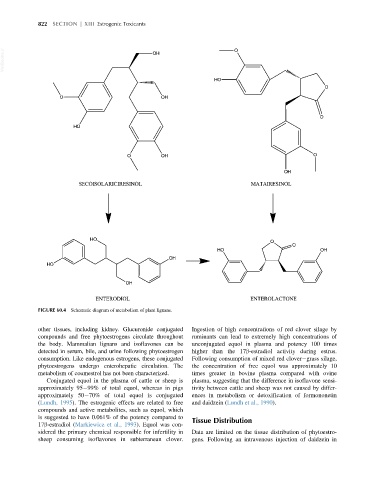Page 864 - Veterinary Toxicology, Basic and Clinical Principles, 3rd Edition
P. 864
822 SECTION | XIII Estrogenic Toxicants
VetBooks.ir
FIGURE 60.4 Schematic diagram of metabolism of plant lignans.
other tissues, including kidney. Glucuronide conjugated Ingestion of high concentrations of red clover silage by
compounds and free phytoestrogens circulate throughout ruminants can lead to extremely high concentrations of
the body. Mammalian lignans and isoflavones can be unconjugated equol in plasma and potency 100 times
detected in serum, bile, and urine following phytoestrogen higher than the 17β-estradiol activity during estrus.
consumption. Like endogenous estrogens, these conjugated Following consumption of mixed red clover grass silage,
phytoestrogens undergo enterohepatic circulation. The the concentration of free equol was approximately 10
metabolism of coumestrol has not been characterized. times greater in bovine plasma compared with ovine
Conjugated equol in the plasma of cattle or sheep is plasma, suggesting that the difference in isoflavone sensi-
approximately 95 99% of total equol, whereas in pigs tivity between cattle and sheep was not caused by differ-
approximately 50 70% of total equol is conjugated ences in metabolism or detoxification of formononetin
(Lundh, 1995). The estrogenic effects are related to free and daidzein (Lundh et al., 1990).
compounds and active metabolites, such as equol, which
is suggested to have 0.061% of the potency compared to Tissue Distribution
17β-estradiol (Markiewicz et al., 1993). Equol was con-
sidered the primary chemical responsible for infertility in Data are limited on the tissue distribution of phytoestro-
sheep consuming isoflavones in subterranean clover. gens. Following an intravenous injection of daidzein in

